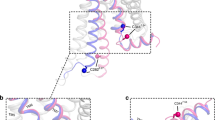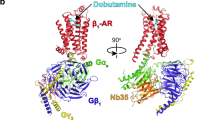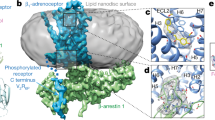Abstract
G protein coupled receptors (GPCRs) exhibit a spectrum of functional behaviours in response to natural and synthetic ligands. Recent crystal structures provide insights into inactive states of several GPCRs. Efforts to obtain an agonist-bound active-state GPCR structure have proven difficult due to the inherent instability of this state in the absence of a G protein. We generated a camelid antibody fragment (nanobody) to the human β2 adrenergic receptor (β2AR) that exhibits G protein-like behaviour, and obtained an agonist-bound, active-state crystal structure of the receptor-nanobody complex. Comparison with the inactive β2AR structure reveals subtle changes in the binding pocket; however, these small changes are associated with an 11 Å outward movement of the cytoplasmic end of transmembrane segment 6, and rearrangements of transmembrane segments 5 and 7 that are remarkably similar to those observed in opsin, an active form of rhodopsin. This structure provides insights into the process of agonist binding and activation.
This is a preview of subscription content, access via your institution
Access options
Subscribe to this journal
Receive 51 print issues and online access
$199.00 per year
only $3.90 per issue
Buy this article
- Purchase on SpringerLink
- Instant access to full article PDF
Prices may be subject to local taxes which are calculated during checkout




Similar content being viewed by others
References
Rosenbaum, D. M., Rasmussen, S. G. & Kobilka, B. K. The structure and function of G-protein-coupled receptors. Nature 459, 356–363 (2009)
Scheerer, P. et al. Crystal structure of opsin in its G-protein-interacting conformation. Nature 455, 497–502 (2008)
Park, J. H., Scheerer, P., Hofmann, K. P., Choe, H. W. & Ernst, O. P. Crystal structure of the ligand-free G-protein-coupled receptor opsin. Nature 454, 183–187 (2008)
Li, J., Edwards, P. C., Burghammer, M., Villa, C. & Schertler, G. F. Structure of bovine rhodopsin in a trigonal crystal form. J. Mol. Biol. 343, 1409–1438 (2004)
Palczewski, K. et al. Crystal structure of rhodopsin: a G protein-coupled receptor. Science [see comments]. 289, 739–745 (2000)
Vogel, R. & Siebert, F. Conformations of the active and inactive states of opsin. J. Biol. Chem. 276, 38487–38493 (2001)
Rosenbaum, D. M. et al. GPCR engineering yields high-resolution structural insights into β-adrenergic receptor function. Science 318, 1266–1273 (2007)
Rasmussen, S. G. et al. Crystal structure of the human β2 adrenergic G-protein-coupled receptor. Nature 450, 383–387 (2007)
Cherezov, V. et al. High-resolution crystal structure of an engineered human β2-adrenergic G protein-coupled receptor. Science 318, 1258–1265 (2007)
Hanson, M. A. et al. A specific cholesterol binding site is established by the 2.8 Å structure of the human β2-adrenergic receptor. Structure 16, 897–905 (2008)
Warne, T. et al. Structure of a β1-adrenergic G-protein-coupled receptor. Nature 454, 486–491 (2008)
Jaakola, V. P. et al. The 2.6 Angstrom crystal structure of a human A2A adenosine receptor bound to an antagonist. Science 322, 1211–1217 (2008)
Ghanouni, P. et al. Functionally different agonists induce distinct conformations in the G protein coupling domain of the β2 adrenergic receptor. J. Biol. Chem. 276, 24433–24436 (2001)
Rosenbaum, D. M. et al. Structure and function of an irreversible agonist–β2 adrenoceptor complex. Nature doi:10.1038/nature09665 (this issue).
Yao, X. J. et al. The effect of ligand efficacy on the formation and stability of a GPCR-G protein complex. Proc. Natl Acad. Sci. USA 106, 9501–9506 (2009)
Hamers-Casterman, C. et al. Naturally occurring antibodies devoid of light chains. Nature 363, 446–448 (1993)
Ballesteros, J. A. & Weinstein, H. Integrated methods for the construction of three-dimensional models and computational probing of structure-function relations in G protein coupled receptors. Meth. Neurosci. 25, 366–428 (1995)
Strader, C. D. et al. Identification of residues required for ligand binding to the β-adrenergic receptor. Proc. Natl Acad. Sci. USA 84, 4384–4388 (1987)
Liapakis, G. et al. The forgotten serine. A critical role for Ser-2035.42 in ligand binding to and activation of the β2-adrenergic receptor. J. Biol. Chem. 275, 37779–37788 (2000)
Wieland, K., Zuurmond, H. M., Krasel, C., Ijzerman, A. P. & Lohse, M. J. Involvement of Asn-293 in stereospecific agonist recognition and in activation of the beta 2-adrenergic receptor. Proc. Natl Acad. Sci. USA 93, 9276–9281 (1996)
Shi, L. et al. β2 adrenergic receptor activation. Modulation of the proline kink in transmembrane 6 by a rotamer toggle switch. J. Biol. Chem. 277, 40989–40996 (2002)
Ahuja, S. & Smith, S. O. Multiple switches in G protein-coupled receptor activation. Trends Pharmacol. Sci. 30, 494–502 (2009)
Pellissier, L. P. et al. Conformational toggle switches implicated in basal constitutive and agonist-induced activated states of 5-hydroxytryptamine-4 receptors. Mol. Pharmacol. 75, 982–990 (2009)
Altenbach, C., Kusnetzow, A. K., Ernst, O. P., Hofmann, K. P. & Hubbell, W. L. High-resolution distance mapping in rhodopsin reveals the pattern of helix movement due to activation. Proc. Natl Acad. Sci. USA 105, 7439–7444 (2008)
Parnot, C., Miserey-Lenkei, S., Bardin, S., Corvol, P. & Clauser, E. Lessons from constitutively active mutants of G protein-coupled receptors. Trends Endocrinol. Metab. 13, 336–343 (2002)
Kobilka, B. K. Amino and carboxyl terminal modifications to facilitate the production and purification of a G protein-coupled receptor. Anal. Biochem. 231, 269–271 (1995)
Caffrey, M. & Cherezov, V. Crystallizing membrane proteins using lipidic mesophases. Nature Protocols 4, 706–731 (2009)
Otwinowski, Z. & Minor, W. Processing of X-ray diffraction data collected in oscillation mode. Methods Enzymol. 276, 307–326 (1997)
McCoy, A. J. et al. Phaser crystallographic software. J. Appl. Cryst. 40, 658–674 (2007)
Afonine, P. V., Grosse-Kunstleve, R. W. & Adams, P. D. A robust bulk-solvent correction and anisotropic scaling procedure. Acta Crystallogr. D 61, 850–855 (2005)
Blanc, E. et al. Refinement of severely incomplete structures with maximum likelihood in BUSTER-TNT . Acta Crystallogr. D 60, 2210–2221 (2004)
Whorton, M. R. et al. A monomeric G protein-coupled receptor isolated in a high-density lipoprotein particle efficiently activates its G protein. Proc. Natl Acad. Sci. USA 104, 7682–7687 (2007)
Acknowledgements
We acknowledge support from National Institutes of Health Grants NS028471 and GM083118 (B.K.K.), GM56169 (W.I.W.), P01 GM75913 (S.H.G), and P60DK-20572 (R.K.S.), the Mathers Foundation (B.K.K. and W.I.W.), the Lundbeck Foundation (Junior Group Leader Fellowship, S.G.F.R.), the University of Michigan Biomedical Sciences Scholars Program (R.K.S.), the Fund for Scientific Research of Flanders (FWO-Vlaanderen) and the Institute for the encouragement of Scientific Research and Innovation of Brussels (ISRIB) (E.P. and J.S.).
Author information
Authors and Affiliations
Contributions
S.G.F.R. screened and characterized high affinity agonists, identified and determined dissociation rate of BI-167107, screened, identified and characterized MNG-3, performed selection and characterization of nanobodies, purified and crystallized the receptor with Nb80 in LCP, optimized crystallization conditions, grew crystals for data collection, reconstituted receptor in HDL particles and determined the effect of Nb80 and Gs on receptor conformation and ligand binding affinities, assisted with data collection and preparing the manuscript. H.-J.C. processed diffraction data, solved and refined the structure, and assisted with preparing the manuscript. J.J.F. expressed, purified, selected and characterized nanobodies, purified and crystallized receptor with nanobodies in bicelles, assisted with growing crystals in LCP, and assisted with data collection. E.P. performed immunization, cloned and expressed nanobodies, and performed the initial selections. J.S. supervised nanobody production. P.S.K. and S.H.G. provided MNG-3 detergent for stabilization of purified β2AR. B.T.D. and R.K.S. provided ApoA1 and Gs protein, and reconstituted β2AR in HDL particles with Gs. D.M.R. characterized the usefulness of MNG-3 for crystallization in LCP and assisted with manuscript preparation. F.S.T. expressed β2AR in insect cells and with T.S.K performed the initial stage of β2AR purification. A.P., A.S. assisted in selection of the high-affinity agonist BI-167107. I.K. synthesized BI-167,107. P.C. characterized the functional properties of BI-167,107 in CHO cells. W.I.W. oversaw data processing, structure determination and refinement, and assisted with writing the manuscript. B.K.K. was responsible for the overall project strategy and management, prepared β2AR in lipid vesicles for immunization, harvested and collected data on crystals, and wrote the manuscript.
Corresponding authors
Ethics declarations
Competing interests
The authors declare no competing financial interests.
Supplementary information
Supplementary Information
The file contains Supplementary Figures 1-6 with legends, Supplementary Tables 1-2 and additional references. (PDF 4062 kb)
Rights and permissions
About this article
Cite this article
Rasmussen, S., Choi, HJ., Fung, J. et al. Structure of a nanobody-stabilized active state of the β2 adrenoceptor. Nature 469, 175–180 (2011). https://doi.org/10.1038/nature09648
Received:
Accepted:
Published:
Issue Date:
DOI: https://doi.org/10.1038/nature09648
This article is cited by
-
Structural basis for the allosteric modulation of rhodopsin by nanobody binding to its extracellular domain
Nature Communications (2023)
-
Function and dynamics of the intrinsically disordered carboxyl terminus of β2 adrenergic receptor
Nature Communications (2023)
-
Dynamic Nature of Proteins is Critically Important for Their Function: GPCRs and Signal Transducers
Applied Magnetic Resonance (2023)
-
Gαi-derived peptide binds the µ-opioid receptor
Pharmacological Reports (2023)
-
Mass spectrometry captures biased signalling and allosteric modulation of a G-protein-coupled receptor
Nature Chemistry (2022)



